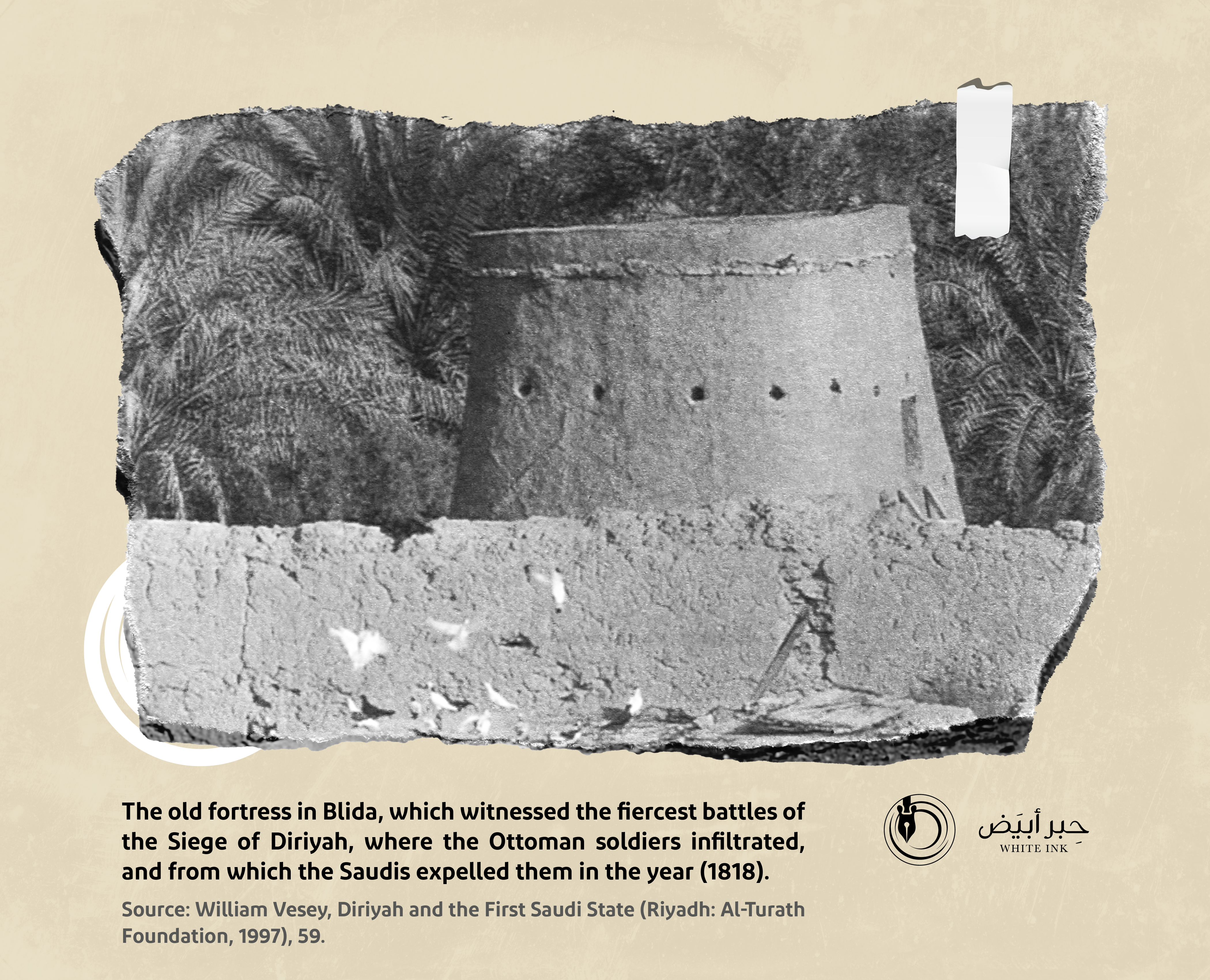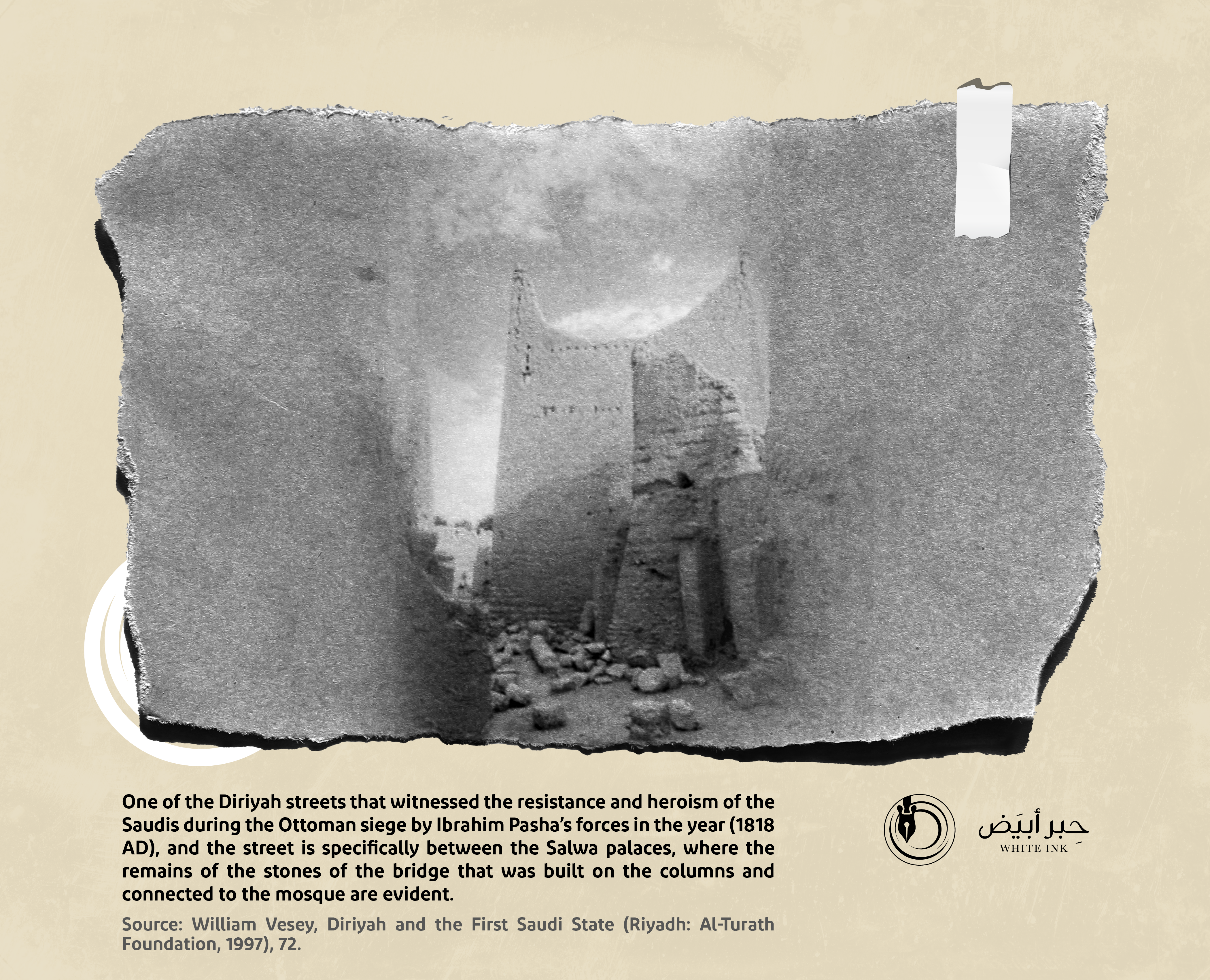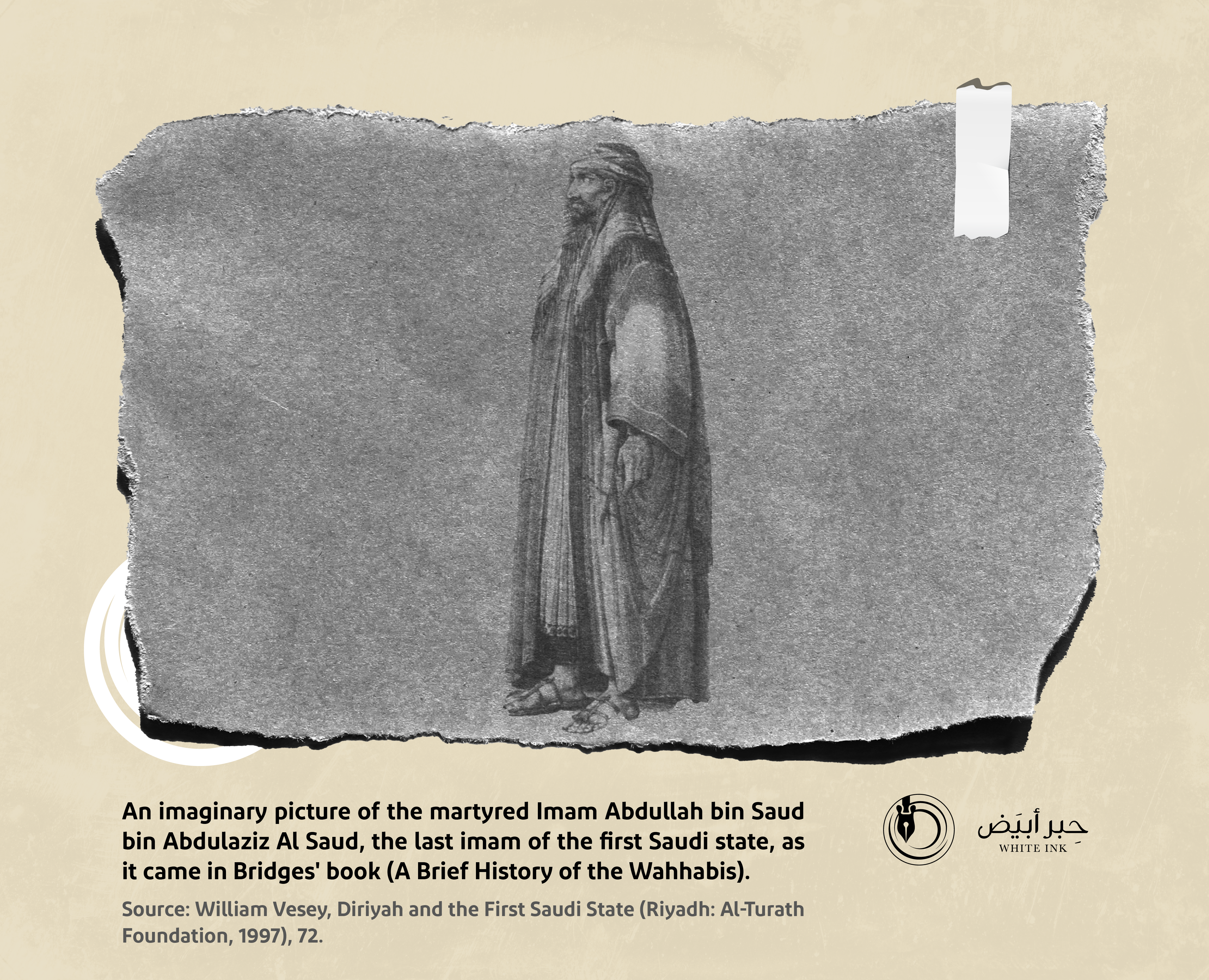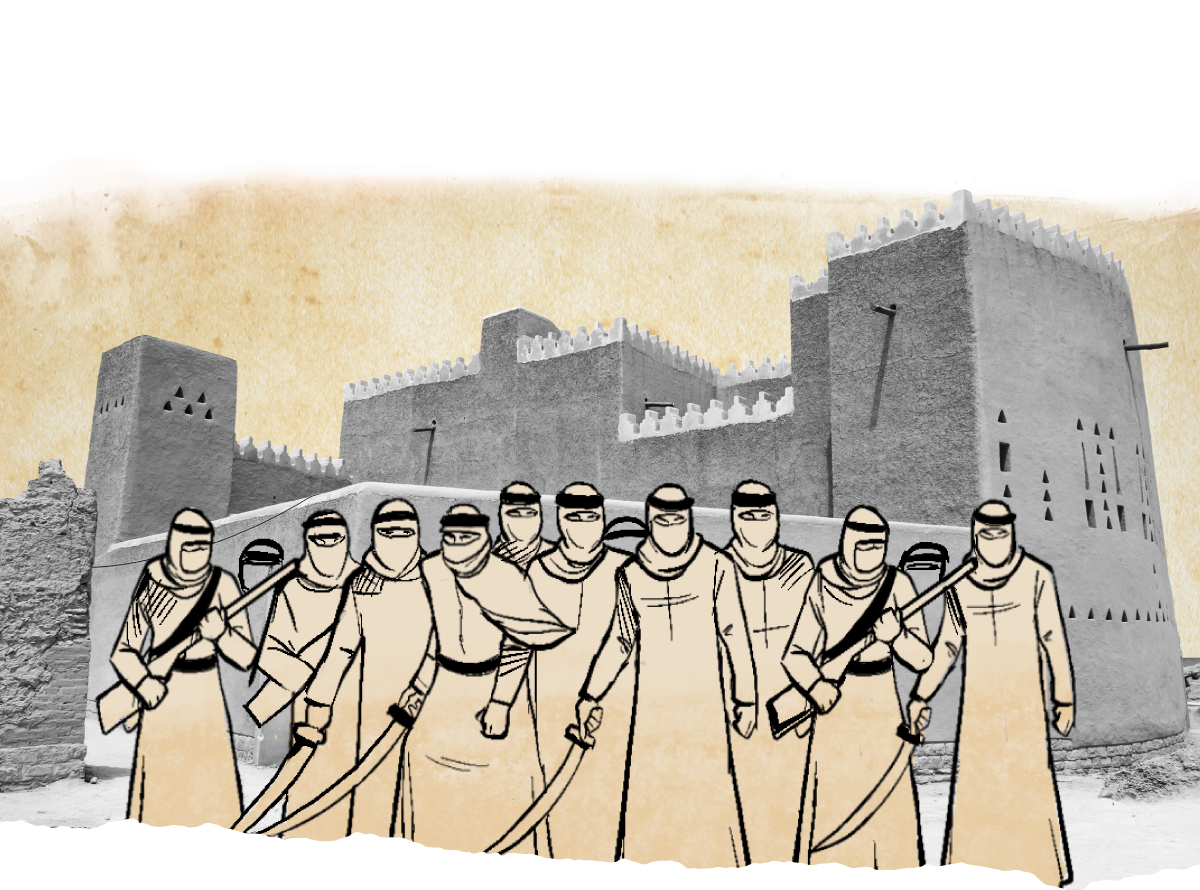
The Fierce resistance fatigued the Ottoman leader Ibrahim Pasha
Military supplies and gears Caused Diriyah to fall despite the Saudi victory in Blida
History has proven that the Ottoman sultans spared no effort in seeking to overthrow the First Saudi State, and despite being defeated by it in more than one battle led by their governors who returned with their tails between their legs after their defeat by the Saudis, the Ottomans continued their stubbornness and terror in killing any Arabian attempt to rise, that was a principle followed by the sultans, to keep their colonization and their exhaustion of the Arab civilization.
The forces of the ottoman governor of Egypt, Muhammad Ali Pasha were the ones who suffered the most from the war against the Saudis, as his forces since they laid their feet on the Arabian Peninsula, faced a fierce resistance, such resistance was due to the Saudis’ belief in defending their country and homeland, in addition to the fact that the ottoman forces suffered from the rugged geographical environment and the far distance to the supply line coming from Egypt.
Due to the persistence of the ottoman governor, Muhammad Ali, to achieve his goal of pleasing the ottoman Sultan and expanding his influence in the Arabian Peninsula, he tried to the change the tide of war by sending more troops and gears, and searching for more effective ways to connect the supply lines with his invading forces, thus, he initially resorted to replace the commander of his campaign, Ahmad Tosun with his other son, Ibrahim Pasha, who was more astute and more militaristic, as well as more brutal and far from human values.
With the arrival of Ibrahim Pasha to Hijaz, the military balance of the Ottoman forces in the Arabian Peninsula changed to a large extent, especially with the arrival of supplies from Egypt and other states, which mobilized the Ottoman Sultan, in addition to putting more of war cannons into the fighting. However, the battles were not easy at all for the Ottomans as they confront the First Saudi State, this is proven by what happened in their siege of Al Rass in (1817 AD), and the resistance they encountered despite changing their strategy, and the size of the forces and gears, which was double the forces and gears in Tosun campaign.
The ottoman governor, Muhammad Ali, insisted on overthrowing the First Saudi State to please his ottoman Sultan and due to his desire to extend his influence to the Arabian Peninsula.

Ibrahim Pasha’s plan after overthrowing Medina was to quickly open the way to Qassim and have it under control; as it is the fastest way to reach the capital of the First Saudi State, Diriyah, which he could hardly reach in (1818 AD), after he insisted on the uninterrupted flow of supplies and gears from his father since he laid his feet into Saudi lands. Despite this significant support, anyone to observe the circumstances of Ibrahim Pasha’s campaign notices the significant losses inflicted on him by the Saudis, even though he managed to overthrow Saudi cities and towns on his way to Diriyah. However, the supply line was a major reason for his arrival in Diriyah, in addition to Ibrahim Pasha’s brutal and vengeful approach against whoever falls into his hands from the people, whoever he is. This caused a state of true form of terrorism, considering that the Arabs were not accustomed to such brutality and inhumanity that they faced from the Ottoman forces, which were presenting hatred and terrorizing the poor people before the fighters, and an excellent example of this was the Ottoman and Ibrahim pasha’s brutality clearly demonstrated in Dharma on his way to Diriyah.
As Ibrahim Pasha was approaching Diriyah, the Saudi forces barricaded there, preparing to defend it against the invading Ottoman forces. Realizing, by their Imam Abdullah bin Saud, that the defense of Diriyah is their important epic battle, and that it is their last resort, so the path for the Ottomans was not paved, as the Saudis continued to defend Diriyah for about six months, during which they made Ibrahim Pasha feels helpless, and caused him several problems by losing his finest and fiercest fighters before the walls of Diriyah, which, despite the siege, stunned the invaders, and made their leader suffer and feared that he would not reach his goal, although all the circumstances indicated that with the arrival of the Ottoman forces behind the walls of Diriyah, the battles would end.
During the Ottoman siege of Diriyah; Several battles took place, such as: Al-Alb, Ghubaira, Samha Al-Nakhl, Al-Salmani, Shoaib Kulikal, the warehouse fire and the Rafia incident. These were the most powerful confrontations against the Saudi army, which fiercely defended its land against the invaders in Shuaib Blida; which is located in the southern region of the city of Diriyah.
The Saudi historian Othman bin Bishr describes that incident, by saying: “It took place at Blida, the well-known Shuaib on the southern side, where several Diriyah’s people were killed, and one of the Romans was killed, then it occurred at Blida also, the Romans attacked the people of Diriyah in their barricades and seized it, and fierce fight took place from noon until the afternoon, subsequently, the people of Diriyah attacked them and expelled them from Al-Mahaji, and they killed several of the Romans, then seized their dead.”
Hit and run battles and incidents continued, and the siege of Diriyah continued until they came to terms and Diriyah fell into the hands of Ibrahim Pasha’s forces, which did not reach their goal until after they incurred significant losses, as they faced great steadfastness from the Saudis who did not abandon their capital, had it not been that the scales of the war were not equal.
Six months of Saudi steadfastness in Diriyah made the ottoman commander doubt his capabilities and his vast army



- Othman bin Bishr, Title of glory in the history of Najd, achieved by: Abdul Rahman Al Sheikh, 4th ed (Riyadh: Ministry of Education, 1971).
- Brydjz, A brief history of the Wahhabi, Translate: Owaidah Al-Juhani (Riyadh: King Abdulaziz Foundation for Reasearch and Archives, 2005).
- Ameen Saeed, State History Saudi Arabia (Beirut: Dar Alkitab Alarabe Publishing, without date).
- Abd al-Rahim Abd al-Rahman, The First Saudi State, 5th ed (Cairo: University book house, 1987).
- Abdul fattah Abu Alih, Lectures in the history of the first Saudi state, 2nd ed (Riyadh, Dar Al Mareekh, 1991).
- Fylks Manjan, the history of the first Saudi state campaigns Mohammad Ali on the Arabian Peninsula, translated by: Muhammad Khair Al-Beqai (Riyadh: King Abdulaziz Foundation (Darah), 2002).
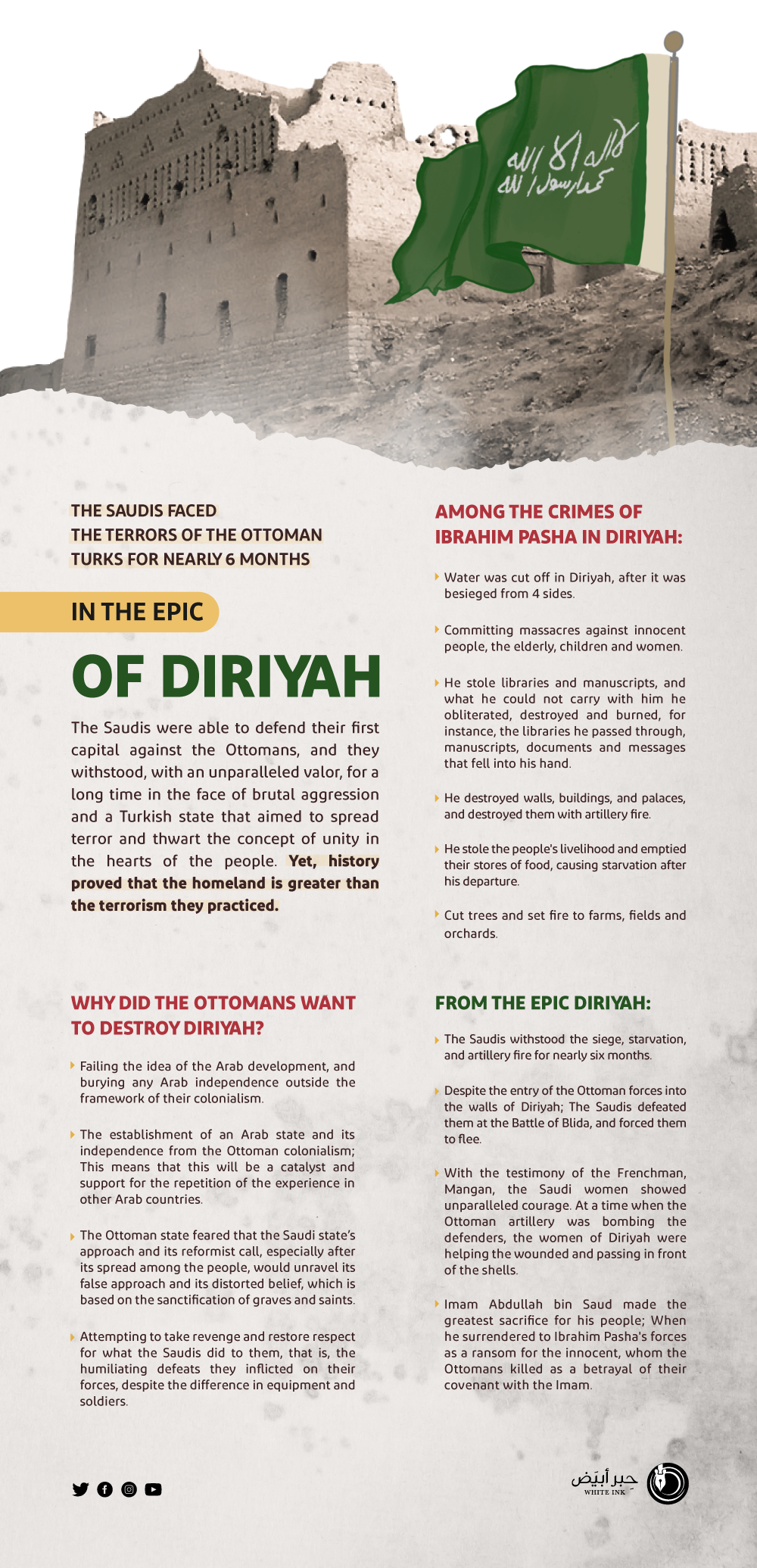
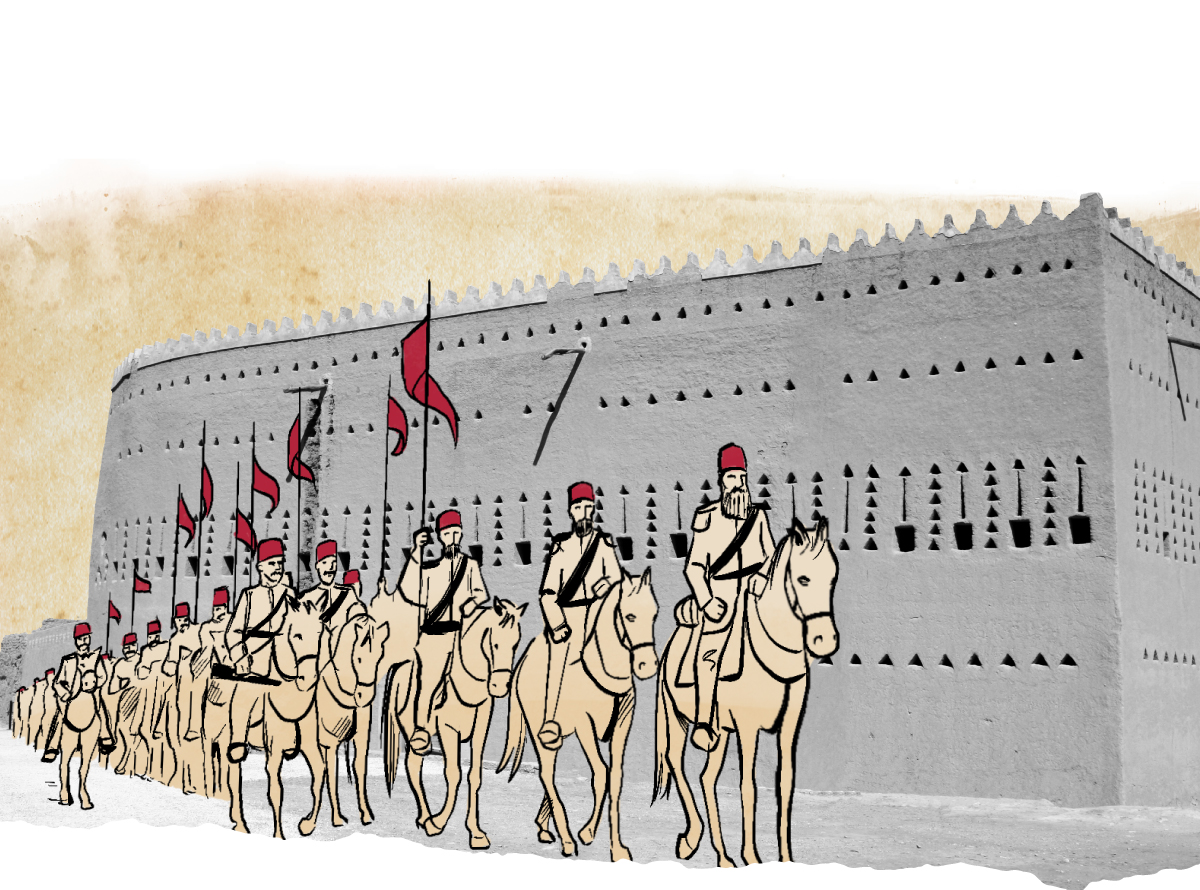
Over whole six months, the Turkish forces have been attrited and depleted of their powers behind the walls
According to the testimony of “Mangan”... Saudi Women Have Overpowered Ottoman Bullets in Diriyah Battles in (1818)
Upon tracking the enmity through which Ottomans became hostile to Saudis; and upon becoming aware of the financial, military and human efforts they have exerted; as well as the firmans they have issued, and the years they have spent in order to eliminate the first Saudi state, the fall of Diriyah would not be a surprise. Rather, one would think deeply of the power that Saudis had, as well as the ferocity that enabled them to stand with their modest means in the face of an imperial power that remained for centuries and expanded east and west.
Upon closely tracking the Ottoman enmity towards the first Saudi state, one would believe that the policy of Ottomans required to suppress any Arabian movement; and insisted on overthrowing Saudis in particular because they were the sole source of the expected Arab renaissance which Turks feared for centuries. Inevitably, it was going to restore the state and ancient glory of Arabs. Therefore, Ottoman Empire recruited all its military and media forces in that time against Saudis. It started with the previous deliberate distortion of the ideology of their country by spreading lies and deceptions; and giving it descriptions such as Wahhabism for the purpose of isolating them from their Arab surroundings, and in order not to be a role model for the others in the Arab world. Ottomans were also convinced that such a country could only be eliminated by military force and through the widest militarization. This was previously indicated in previous topics of tracking the process of driving the military campaigns of Ottoman governors in Iraq, Levant, and Egypt that invaded the Saudi state. Such Ottoman policy that started with the establishment of the first Saudi state in (1744), and particularly two years later with its first publically declared hostile attitude that was reflected in its failed campaigns which it launched from Iraq.
By reviewing the Ottoman interaction with the first Saudi state, we notice that they considered the Muslims of Diriyah to be more dangerous to them than Europe that was incompatible with their religion and doctrine. Therefore, during that period, Ottomans practiced peace before Europeans and exchanged interests and diplomatic envoys with them. This means that Ottoman Sultan and his governors were afraid of the dignified Diriyah that was located in the heart of the desert and of which Turks were ignorant. It was near the terrifying Sand Sea with its prestige that was similar to that of its inhabitants. They feared it more than Europe with all of its countries.
Europe, including its countries and forces, did not embarrass Ottoman throne as Saudis did.

This explains the excessive, brutal, and inhuman use of Ottomans of military force against Diriyah in their last battle with Saudis. Thus, it was proved that Ottoman Empire fought Saudis with terrorism more than military force and without giving any weight to honor, courage and chivalry by Turks and their governors in the battlefield. Therefore, they killed defenseless children, women, and men without mercy. They betrayed without bravery, and had the audacity to shed infallible blood and kill innocent civilians with full meanness, without batting an eyelid.
Ottomans have killed innocent people and prohibited people from having food or water in an effort to terrorize Saudis.

All this because the great epic of Saudis against them was greater than they imagined, and stronger than they expected; starting from the arrival moment of their invaders from Iraq, then Egypt. However, they started from Yanbu, passed through Al- Medina Al- Munawwara where Wadi Al- Safra battles tool place; then Taif and Turabah, as well as Wadi Basl, Al- Qunfudhah, Al- Bahah, Asir, and finally the capital of the first Saudi state Diriyah.
Perhaps the most dangerous thing that Ottoman Empire has done and failed at, the same time, was its attempt to eradicate the ideology and identity of the first Saudi state from the bottom of the Arabian Peninsula so that it would not rise again after their crimes in Diriyah. Therefore, Ottomans did not leave any manuscript or book without confiscating it; neither did they leave a scholar without killing or deporting him from his homeland in an effort to keep the Saudi country in ruins, without cognitive memory that would resurrect and establish the country once more.
Ottomans were not aware that the Saudi country was established in the hearts of people, and drew its homeland whose borders were the hearts of the Saudis who were attached to their Imams and their thoughts. This is proven by the fact that as soon as their armies left the roads and squares of Diriyah, Saudis returned to their former condition, spreading the sound tenets of Islam, as well as establishing schools and seminars. It was only few years until the second Saudi state was launched.
Before the barbarian Turkish Ottoman Empire attacked it; destroyed, and burned its walls, Diriyah was the best city of all cities of the first Saudi state. It was also its capital after it had been turned into a meeting point of science and politics in the Arabian Peninsula that did not include a unified state since early period of Islamic history. However, Diriyah came to awaken the glory and power of Arabs once more after the identity had been lost for centuries.
The first priority of Saudis across their capital, Diriyah, and all of their towns was to prevail safety and security, let sustenance to be expanded, spread justice and science so that the population would feel the state impact in their life and livelihood. Therefore, Saudi historian, Othman Bin Bashir, described the condition of Diriyah saying, “When one entered its scope, he could not lose anyone of the people of the surrounding countries such as, Yemen, Tihama, Hijaz, Oman, Bahrain, Syrian Desert, Iraq, their inhabitants, and other people of the surrounding horizons which are countless. Some enter it, some leave it, and others live in it”.
In spite of the major battles waged by the Saudi armies in several provinces in defense of their country against Ottoman invaders who came from the Ottoman garrisons in Arab countries under orders of Istanbul, starting from Al- Ahsa, Hijaz, then the provinces of Tihama, Taif, and Asir, such fierce resistance of Saudis against Ottoman army was exhausted due to the advanced weapons used by Ottoman Empire, as well as the great supplies and efforts harnessed by Istanbul for its armies with the aim of eliminating Saudis in their towns. This affected the fall of the Saudi towns, one after another, until the forces of Ibrahim Pasha reached the town of Diriyah, the capital of the first Saudi state, and clamped down on them by blockading them in (1818).
The cruel blockade lasted for several months during which Diriyah and its people have suffered from hunger, lack of medicine and water due to terrorist use of force against people during the attempts of raiding it. When Ottoman invaders penetrated the walls of Diriyah, this was the formal fall of the first Saudi state. Saudi forces were not able to repel the last attack despite the bravery of defenders and civilians of the people of Diriyah who united in one block against Ottoman terrorism.
The defenders had to retreat. With the constant pressure on the city, Imam Abdullah Bin Saud moved from Bab Samhan to Al- Turaif district where he was fortified after Ibrahim Pasha forces had seized the south of Diriyah. Imam Abdullah found that continuing the fight would result in a humanitarian catastrophe regarding his people in the face of an army and a state that did not estimate neither religion, nor values. Thus, after six months of Diriyah blockade, in Dhul Qa’dah of (1233 AH), he, May Allah have mercy on him, announced his request of peace and security for Diriyah and its people in return for surrendering himself. Imam Abdullah surrendered himself with his soldiers in order to redeem the innocent ones of his people. He was taken to Cairo, then to Istanbul, the capital of Ottomans where their sultans deceived him and betrayed their covenant by killing him as a martyr in spite of their promises to the contrary.
Imam Abdullah Bin Saud surrendered himself to the forces of Ibrahim Pasha to redeem the innocent ones of his people.

The overthrow of Diriyah by Ottomans was not just a military action, it was rather a termination of the project of renaissance and reform led by the first Saudi state since its establishment up to its fall. Therefore, after overthrowing the state and upon leaving Diriyah, Ibrahim Pasha has sought to take all books, as well as scientific and religious theses that he has found there. Upon his arrival in Huraymila, he picked ten loads of them, then, he burned the rest. Nothing was left of the documents, theses, and books that were once contained in the bookcases of Diriyah.
Ibrahim Pasha stole books; destroyed and burned libraries with the documents and correspondences which became in their possession after the fall of Diriyah.

Correspondences between Ottoman governor, Mohammed Ali Pasha, and his son revealed that the battles between Ibrahim Pasha and people of Diriyah started once he arrived there in (1818). He dug in order to set ramparts opposite to the ramparts of Imam Abdullah Bin Saud. Ibrahim Pasha described the military plan of Imam Abdullah as follows: “Since Diriyah was located between two mountains, Abdullah Bin Saud divided his men to be deployed on the mountains and the edges of Diriyah strait and inside the various gardens- farms. The rest of his aides were inside walls and towers. He seriously fortified his ramparts so that no missiles would penetrate it”. This indicates that Imam took the initiative to shoot in defense of his town.
During the intensification of Diriyah battles and while men stationed on walls, women had an important role. The Frenchman, Felix Mangan, who resided at the court of Mohammed Ali Pasha and who reviewed the correspondences of soldiers and Ibrahim indicated this saying, “Imam Abdullah knew about the absence of Ibrahim Pasha from his camp so he ordered his men to hit all the lines of Turks. The battle continued violently and hard. The fire of guns and weapons lasted for several hours. The temperature was very high. We saw the women of Saudi state carrying jars full of water and passing in front of gunshots bravely to water defenders of soldiers”.
After whole 6 months of continuous fighting and blockade, Ibrahim Pasha could not end the battle against Diriyah except after the arrival of huge supplies which were sent by his father, Mohammed Ali Pasha. Thus, Ibrahim began preparing for the last attack. He began gathering his cannons around the four sides of Diriyah and mobilized his cavalry and soldiers at the southern side of Diriyah. Nevertheless, he focused his cannons on the northern side more than other sides. Ibn Bishr described this saying, “At down, cavalry and soldiers headed to Musheirifa in the southern side which was carefully checked by Imam Saud Al- Kabeer bin Abdulaziz, and he found it empty. They entered and seized it. After that, the general attack started everywhere to distract people of Diriyah from seizing Musheirifa”. Ibn Bishr continued: “Fighting intensified between the two sides. It was not long until the cavalry and soldiers of Ibrahim Pasha assailed the people of Diriyah from the direction of Musheirifa. People of Diriyah were surprised by them and were embarrassed, then defeated. Therefore, they left their positions and dispersed. All people of Nazla headed to their homes and deployed in the neighborhoods where they sought protection. They included Sa’d Bin Imam Abdullah Bin Saud Al- Kabeer who was fortified in Ghasaiba Palace with five hundreds of his followers. As for Imam Abdullah Bin Saud Al- Kabeer, he was in Samhan at its gate, at that time, with a group of the people of Diriyah who were fighting for it. When he knew about this advancement, he moved from Samhan to his palace in Al- Turaif where he was fortified. Soldiers of Ibrahim Pasha seized Samhan and started shooting the owners of homes with cannons. The people of the plain assailed them between the two mountains headed by Sheikh Abdullah Bin Sheikh Mohammed Bin Abdulwahhab Al- Tamimi and his son Sheikh Suleiman who were desperate to drive out the forces of Ibrahim Pasha. Their fighting continued in the streets and in front of the houses until night. They managed to dislodge the forces of Ibrahim Pasha after many people had been killed. They wanted to make reconciliation with Ibrahim Pasha regarding the whole country but he refused, except for the plain. Fighting between the two sides resumed. In addition, Ibrahim Pasha focused his cannons on the road where Imam Abdullah Bin Saud Al- Kabeer has sought protection. Some sides of the palace were demolished. Imam Abdullah got his cannons out of it and moved them to Al- Turaif mosque. He started shooting his enemy from there with a group of the people of Diriyah. This condition lasted for two days in fierce fighting. Then, the followers of Imam Abdullah decreased where all of the forts were overpowered on the second day of the attack and none was left but him.
Ibn Bishr added, “When Imam Abdullah saw this, he gave himself up and redeemed women, children and money. He corresponded the Pasha and requested reconciliation. The Pasha ordered him to come out to him. He came out and they reconciled, as he had to go to Sultan. That was the case according to which the reconciliation was concluded.


- Othman Bin Bishr, The Title of Glory in the History of Najd, edited by: Abdulrahman A’l Al- Sheikh, 4th ed. (Riyadh: Ministry of Education, 1971).
- Felix Mangan, The History of the First Saudi State and the Campaigns of Muhammad Ali on the Arabian Peninsula, translated by: Mohammed Khair Al- Baka’e (Riyadh: King Abdulaziz Foundation for Research and Archives, 2002).
- Abdulrihim Abdulrahman, The First Saudi State, 5th (Cairo: University Book Center, 1987).
- Abdulfattah Abu Alya, Lectures on the History of the First Saudi State (Mohadarat Fi Tarikh Al- Dawla Al- Saudia Al- Oula) (Riyadh: Al- Marikh publishing house, 1991).
- Fatima Al-Qahtani, Ibrahim Pasha Campaign against Diriyah and Its Fall (Hamlat Ibrahim Pasha Ala Al- Dir’iyyah wa Su’qotoha) (Riyadh: King Abdulaziz Foundation for Research and Archives, 2009).
- Hamad Al-Anqari, The Manuscripts of the First Saudi State Libraries: Analytical Study of the Factors of Its Transition and Disappearance After the Fall of Diriyah (Maktabat Al- Dawla Al- Saudia Al- Ola Al- Makhtota: Dirasa Tahlilya Li’wamel Intikalha wa Inditharha Ba’d Sokot Al- Dir’iyyah) (Riyadh: King Abdulaziz Foundation for Research and Archives, 2009).
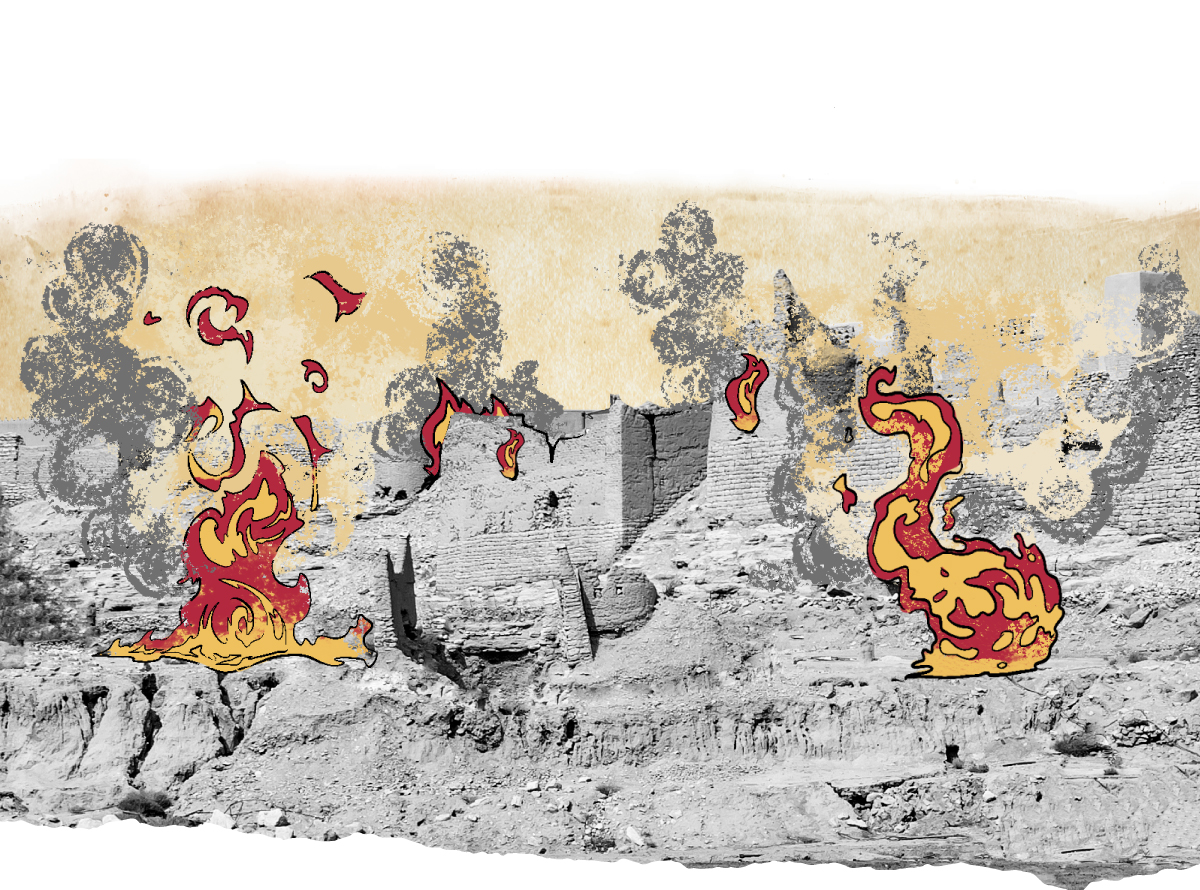
A dark historical memory stands a witness on their crimes
Ottomans betrayed Islam in Diriyah
Anyone who is up on the events and a reader of Islamic history, and familiar with the method of military confrontations led by Islamic armies in their usual state in the historical confrontations, as Muslims were keen to apply a set of moral and value rules that only some organizations and people of misguidance have deviated from, especially those who insisted on a strict understanding of the texts of Islamic legislation, and took them out from their context and twisted the texts to serve their strict approach and their takfirist and bloody approach.
Among what Muslims hold on to in their wars, was what was mentioned in the will of the rightly-guided Caliph Abu Bakr al-Siddiq – may God be pleased with him – to Yazid bin Abi Sufyan when he sent him to Syria, where he advised him saying: “And you will find people who have locked themselves in these hermitages, so leave them be.” Do not kill an old man, nor a woman, nor a young child, do not destroy a building, do not cut down a tree except for a benefit, do not kill an animal except for a benefit, do not burn palms, do not drown it, do not betray, do not mutilate, do not be a coward, or jealous.
From the standpoint of the principles of war in Islam against the infidels and polytheists, what would the situation be like if it was a war against a Muslim who was defending his land and territory, and believed in his faith. This is what the Ottoman Empire did not give pay attention to in its war against the first Saudi state, this Turkish state that made religion and Islam a slogan rather than a life practice and an approach to follow; at the time when it claimed that it represented the Islamic caliphate, which was way too far from it, it was dealing with the Muslims themselves extremely unjustly, terrifyingly and maliciously, and doing what was similar to the actions of the barbarians and Turkish cousins from the Mongols, as the Ottomans proved that they do not give care about the ethics of Islam, especially concerning wars and adhering to what Islam commanded in regarding the matter, whatever the causes and circumstances of the war, and with whom.
In this regard, the first sign of the Ottomans’ terror in Diriyah was clearly manifested in the attack of Ibrahim Pasha’s forces from four sides in a strategy similar to the “pincer jaws” and the demolition of the walls with the bullets of cannons, which the Diriyah armies faced with unparalleled courage and determination, in a position described by the Saudi historian Ibn Bishr, saying: And they rose up against the Romans from all sides as if they were lions, and fought a battle so devastating, so the Al-Hujaira became dark as if it was night, and swords shrieked over the heads as if the neighing of horses.
Despite the fierce resistance of the Saudi armies, the length of the siege, which lasted nearly six months, ended with the fall of the capital of the first Saudi state after Imam Abdullah bin Saud sacrificed himself to redeem the lives of Saudi subjects, which Ibrahim Pasha accepted provided that he is to be sent to Egypt so that the Ottoman governor, Muhammad Ali looks into his matter.
In reference to the aforementioned about the rules of war; What the Ottoman forces did are war crimes in the modern and contemporary sense, which can only be committed by criminals, who are not recognized by humanity, and cannot be committed by human beings, so how if such crimes were committed by a state that claims to represent Islam and Muslims.
Based on what was described in the history books, Ibrahim Pasha’s soldiers invaded Diriyah in a devastating scene, which Ibn Bishr describes by saying: “Then he commanded the soldiers to demolish its houses and palaces, cut down its palms and trees, and show no mercy to its young or old… They set fire to it and expelled all the residents and left it empty, as if there was no inhabitant before.”
In both modern and contemporary sense, Ottoman terrorism in Diriyah is classified as a war crime.

Regarding the same matter, pictures of the destruction of Diriyah by the Ottomans were captured, and we find the Englishman Bridges describing one of these scenes, saying: “Turkish infantry forces followed the fugitives into the city’s fields, where they captured and killed them Instantly. The soldiers took the heads of the dead ones and their ears to their leader to get paid.
Diriyah was brutally and retaliatorily violated despite the surrender of the imam of the first Saudi state in exchange for safety for its people, which proves that the goal was not only a military victory, but to erase every trace of the Saudi state, this goal is added to the desire of the Turks not to allocate any military garrison to Diriyah and turn it into ash, which British George Sadler confirms by saying: “I have received news of the complete destruction of Diriyah, and it seems to me that the intention of the destruction was not only to end the Wahhabi authority, but also not to allocate military forces to protect it, and therefore it was necessary to be demolished. as he did.”
The British Sadler conveyed his convictions about the crimes of the Turks in Diriyah that it was not just an overthrow of a state.

In summary, it can be said that the destruction of Diriyah embodied a black historical image that is still uttering the crimes of the Ottomans in the Arab region, and its land still narrates the story of the heroism of the imams of the Saudi state who sacrificed themselves to save the blood of Muslims, and established to cleanse the land from the Ottoman colonizer to remain a source of inspiration for those who came after and followed their path until in (1932 AD), they were able to establish a strong state by the hands of the late founder, King Abdulaziz bin Abdulrahman Al Saud, may God have mercy on his soul, and his state was able to reserve a place for it in a world that does not give weight and consideration except to big fish such as the Saudis.
Therefore, nothing remained from the history of Ottomans but shame and dark pages, which the Saudis obliterated with their courage, strength and homeland, who had won over the invading forces and cleansed their land from them, despite the military and intellectual terrorism used by the Ottoman Empire against them, with the advanced military machinery at the time and the powerful forces it sent to the Arabian Peninsula, in addition to the systematic campaign through which it tried to distort the good image of the Saudis.


- Mohammed Al Waaqidi, Fattouh Sham (Beirut, Dar Al-Kotob Al-Ilmiyah, 1997 AD).
- Othman bin Bishr, Title of glory in the history of Najd, achieved by: Abdul Rahman Al Sheikh, 4th ed (Riyadh: Ministry of Education, 1971).
- Brydjz, A brief history of the Wahhabi, Translate: Owaidah Al-Juhani (Riyadh: King Abdulaziz Foundation for Reasearch and Archives, 2005).
- George Sadler, a journey through the Arabian Peninsula, Translated by: Essa Ameen (Beirut: Arab Institute, 2000 AD).
- Abd al-Rahim Abd al-Rahman, The First Saudi State, 5th ed (Cairo: University book house, 1987).
- Abdul fattah Abu Alih, Lectures in the history of the first Saudi state, 2nd ed (Riyadh, Dar Al Mareekh, 1991).


